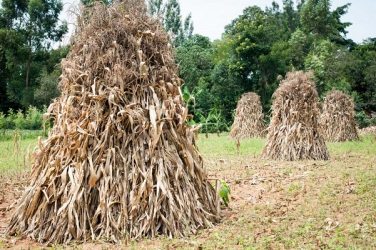Maize is probably the most common crop in Kenya owing to the fact that it is a major constituent of our staple food – the ugali. After harvesting the maize cob, farmers either let their animals into these farms to eat the leafy dry parts of the crop; others simply cut them and throw them on the side to pave way for another season. Some set them on fire.
This is a big waste that should be avoided in all seasons considering the high cost of feeding animals. Farmers actually overlook this economical source of feed for their livestock right in their backyard.
Still, those who attempt to use it fail to extract maximum energy from maize stovers. Yet this is a strategy that can be adapted to lower cost of feeding without necessarily lowering the physical growth process and productivity.
Maize stovers is that part of a maize plant left after harvesting the maize cob at maturity composed of the stalk and the dry leaves.
Feeding regime
Harvest seasons are normally punctuated by dry spells that create favourable weather conditions for clearing farms in anticipation of the long or short rains. My late grandmother Okolwe (as we fondly referred to her) in her indigenous knowledge used to tell us that the hot sun is killing the worms in the soil; a fact I later confirmed in agricultural literature.
When the short or long rains come, green grass spontaneous sprout and livestock will happily devour lush green pastures but will soon afterwards suffer bad diarrhoea and production will certainly be affected. This diarrhea will have a characteristic green colour and is mainly caused by the sudden change in feed and the high moisture content of young grass. But this can be prevented by incorporating roughages like maize stovers into the feeding regime.
So that we can understand the importance of maize stover; let us learn other two concepts applied in animal feed management namely concentrates and roughages.
This is a broad classification of animal feeds depending on their composition and they are basically opposites. While concentrates contain high density of nutrients, are highly digestible but are low in fibrous tissue; roughages have low nutrients density but have high fibre content. Concentrates thus provide energy, proteins, amino acids, fatty acids, vitamins and minerals and are commonly fed to monogastric livestock (animals with one stomach like poultry, pigs) since they have minimal capacity to digest roughages but they need it to aid in the very digestion. High levels of concentrates are used in intensive systems at certain periods in milk production or fattening in ruminants. Concentrates are also useful in improving the uptake of roughages by increasing their palatability. In terms of cost; concentrates are more expensive than roughages.
Nonetheless roughages are an important component of a ruminant diet. They also create a psychological filling of satisfaction which an animal needs.
Maize stoves are an example of roughages and with good utilisation they come in handy when it is dry as a complement to forage seasonality and as a top up for lactating cows, weaner calves and draught animals. They have been shown by research to provide up to a third of dry matter to pregnant cows in her first eight months.
The palatability and digestibility of maize stovers can be improved using two methods namely physically and mechanically. The aim is increase their nutritive value by increasing their intake and promoting their digestion in the rumen through fermentation. Physically, the stalks and dry leaves can be chopped or ground into smaller pieces that make ingestion easier.
Adding value
Chemical treatment is another way of adding value to maize stovers and involves the addition of hydrated lime (mixing water with calcium derived from limestone) to chopped or ground maize stovers.
This mixture is then stored in a plastic bag to lock out oxygen; this solution and storage makes the stovers more digestible therefore greatly improving its nutritive value by increasing their protein content. I have observed in various farms the addition of molasses to maize stovers a practice that makes them more appetising to livestock.
It is believed that molasses aid in fermentation process in the rumen and therefore the digestible of the maize stovers. This is still a subject of research but I cannot hesitate to market its adoption.
When you decide to harvest your maize earlier when they are still green; the stovers can still be used to prepare good quality hay although the use of the dry stovers is not recommended in silage making.








